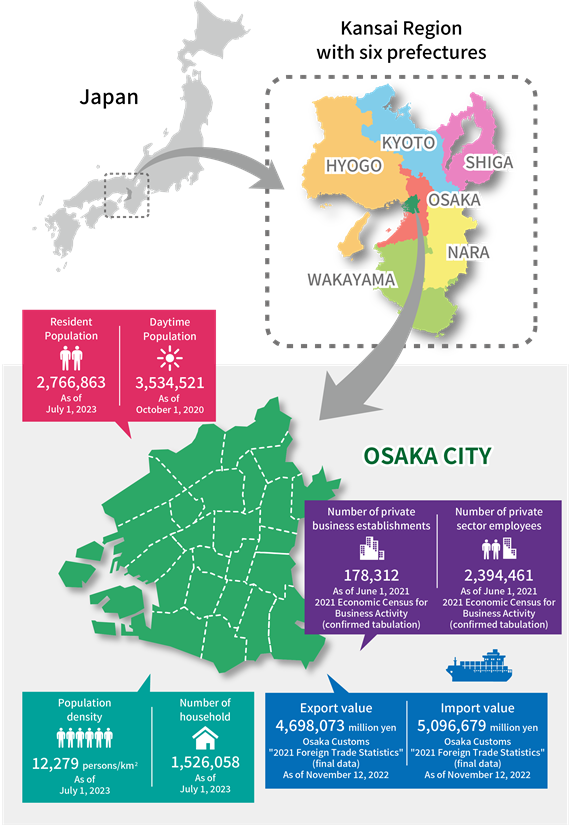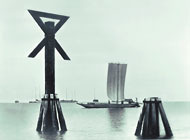Profile of Osaka city
City Profile
Area and population
Area: 225.34 km² (As of April 1, 2024)
Report of statistical reports on land area by prefectures and municipalities in Japan in 2024 (Geospatial Information Authority of Japan)
Population: 2,788,758 (As of July 1, 2024)
Location:

City Emblem


The Miotsukushi of ancient lore is a sign that was placed in the shallow waters of Naniwa-e Bay. Settsumeishozue (a tourist guide published in 1796-1798) shows only X-shaped panels nailed to a pile, but signs shaped like the modern city emblem are found in drawings from the Tempo Era (1830-1844). Osaka’s prosperity has long been due to transportation by water and to ships coming in and out. Therefore, the Miotsukushi, with which people were familiar through close identification with the port, was chosen as the city emblem in 1894.
City Flowers
The Osaka City flowers are the cherry blossom and the pansy. They were selected by the citizens in 1987.


City Status
Osaka was given city status on April 1st 1889. However, at that time, the governor of Osaka Prefecture also served as the Mayor of Osaka City: this exceptional system was also in place in Tokyo and Kyoto.
Bridges in Osaka "The 808 Bridges of Naniwa"
Osaka developed around the mouths of the Yodo River and Yamato River, with many rivers and canals running through the city. Since there were so many bridges built in the Edo Period throughout Naniwa (now Osaka), many people used the figurative phrase “The 808 Bridges of Naniwa” to describe them.
Among these bridges, twelve were administered directly by the shogunate government and decorated with
These bridges in Osaka have played an important role in supporting the lives of those people in the commercial city of Osaka and the development of the city. Although the bridges have changed their appearances as time has gone by, they still remain in use today as if to convey the vibrancy of the city at the time they were built.
Today, the bridges in Osaka play various roles, not only for crossing rivers, but also for conveying history and adding to the city’s landscape; thus, bridges have now become essential when talking about Osaka, the Aqua Metropolis.
Click here for a map of the 808 Bridges of Naniwa
- The 808 Bridges of Naniwa map1 [PDF/442KB]
- The 808 Bridges of Naniwa map2 [PDF/797KB]
- The 808 Bridges of Naniwa map3 [PDF/695KB]
- The 808 Bridges of Naniwa map4 [PDF/416KB]
Mayor
The first mayor of Osaka was Tahee Tamura who took office on October 12th 1898. Before the war, elections were carried out in the city council. As of April 1947, public elections have been the method used to select the mayor. The term of office is four years.
City Council
The city council is composed of 86 members. They are elected by ward and serve a four-year term of office. In addition to the regular triannual assembly, extraordinary sessions are also held whenever necessary. There are six standing committees: Finance and General Affairs; Education and Youth; Public Welfare and Health; City Planning and Economic; Construction and Fire Defense; Transportation and Waterworks.

